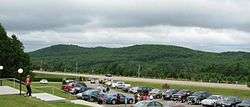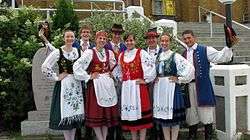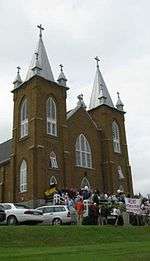Wilno, Ontario
The community of Wilno, Ontario is situated on the border of Killaloe, Hagarty and Richards and Madawaska Valley townships in Renfrew County, Ontario.
Geography
Wilno is nestled in the rolling, picturesque terrain of the Madawaska valley which was largely shaped during the demise of the Laurentide Ice Sheet at the end of the last North American Ice Age.
History
Wilno is the first and oldest Polish settlement in Canada. The original settlers in this area, circa 1858, were from the Kaszuby region Kashubian from the then Prussian area of Poland. They constitute an integral part of what has been called the Kashubian diaspora.[1] One of the reasons they chose this area to settle was because of the landscape which reminded them of their original homes.

Wilno's namesake was the city of Vilnius (Wilno in Polish), then in a Russian-occupied area of Polish–Lithuanian Commonwealth, now capital of Lithuania, the birthplace of Reverend Ludwik Dembski, who was a prominent community spiritual leader and town founder, who would not have wanted the town named after himself. Therefore, the townsfolk, grateful for his contributions to their town, may have suggested the name of Wilno.[2][3]
The first church, known as St. Stanislaus Kostka Church, was built in 1875, destroyed by fire in 1936 and rebuilt as Saint Mary - Our Lady of Czestochowa. It is now known as St. Mary's Catholic Church. The first general store and post office was initially operated by Adam Prince (1855-1933) who became the community's first postmaster in 1885. The settlement was initially named Princetown before being renamed Wilno. Flora’s Store was started by Flora Bank in 1937; it was destroyed by fire in 1940 but rebuilt. The business went through several owners and changes but was closed down in 2015.[4][5]
In 1894 the Canadian Atlantic railroad arrived in the Madawaska Valley.[6] Previously, John Rudolphus Booth's Ottawa, Arnprior and Parry Sound Railway ran through the town mainly serving the lumber industry. The first hotel near the Wilno rail station was the "Stopping Place"; a new owner added more rooms and a dining room, and re-named it the "Exchange Hotel". Subsequent owners modified the property and it became the "Wilno Tavern" in 1979 and the "Wilno Tavern Restaurant" more recently.[7] The restaurant remained in operation as of 2020; Corinne Higgins has owned it since 1981.[8]
The former train route has now been redeveloped into a recreational path. Where the former train station was located, an early settler building and museum that present the early history of the town was built. The museum and open air wooden skansen (Swedish for "ethnographic museum") contain the history of the first Kashubian people as well as their immigration to Canada, freedom and eventually, after many hardships, their settlement journey to the Wilno area. The Polish Kashub Heritage Museum & Skansen opened in 2002. It is open to visitors during July and August; in May, the annual Kashub Day event is held here.[9][10][11]



Other noted Kashubes include the Kashubian-Canadian priest and historian, Rev Aloysius Rekowski (1921–2006) who was born and raised in Wilno and, Martin Shulist,[12] who talks of the traditions behind The Holy Crosses of Wilno and their significance to the settlers of this area. Every August in Wilno, Canada's Kashubian community celebrates their heritage.
A professor of Slavic Languages, Jan L. Perkowski, reported on rumours of vampires in the Kashubian culture in a study completed in 1969, and published in a paper titled "Vampires, Dwarves, and Witches among the Ontario Kashubs".[13] According to the professor, Kashubs call the vampire "vjeszczi or wupji" and he stated that the Ontario Kashubs believed that one "must open the tomb of the vampire at midnight, and drive a long nail into his forehead, or, better still, cut off his head with a sharp spade and put it between his feet...."[14] In 1973, a Catholic priest in Wilno told a CBC journalist that "We get a big laugh out of it, we know the people who have manufactured the story just by reading it ... That nonsense of driving nails. My impression is that he probably stuck a microphone under their noses and to get rid of him they'd made up these tales".[15] Kashubians in Wilno interviewed by another journalist in 2019 "vehemently [denied] that they still adhere to this medieval remnant of the Fatherland. What’s less ambiguous is that fact that there are some Ontarians do believe in vampires… some say, with good reason".[16]
In April 2010, Poland's Prime Minister Donald Tusk agreed to visit Wilno but an airplane crash, the Smolensk air disaster, that took the life of President Lech Kaczyński, and that of 95 others, led to cancellation of the plan.[17] In May 2012, however, Tusk did visit Wilno and said that he was the "first Polish prime minister to meet with the minority living there and cultivating its customs since the 19th century".[18][19] He toured the Catholic cemetery and later said, "We felt as if we were visiting the graves of our dearest, our relatives, our beloved, because these names, these figures, those stories were our stories."[20]
In September 2015 three women; Carol Culleton, 66, Anastasia Kuzyk, 36, Nathalie Warmerdam, 46 were murdered in and near Wilno. The killer, Basil Borutski, was subsequently charged and convicted of the crimes.[21]
Historical plaque
The government of Ontario erected a historical plaque in Wilno, providing these specifics:[22][23]
The first group of Polish immigrants to Canada, some 300 in number, established a settlement in this area in 1864. Adverse social conditions and political unrest in their partitioned homeland had encouraged them to leave. They cleared the land and rapidly established a thriving agricultural community. During the 1880's the village founded here was called Wilno after the birthplace of the Reverend Ludwik Dembski one of their spiritual leaders. In 1875 the parish of Wilno was organized and a chapel dedicated to the polish saint Stanislaus Kostka, was built. The Canadian Atlantic Railway linked Wilno with Ottawa in 1894. This district, which received a new wave of Polish immigrants in the early 1900's, retains much of its cultural heritage.
Annual Chicken Supper on the Labour Day Weekend

This supper has been an annual event since 1936. Approximately 2,000 people have been served each year during Labour Day Weekend. The food is authentic Kaszebe–Polish fare; one source states that it includes "boiled chicken, mashed potatoes, gravy, fresh vegetables, such as carrots, cucumbers, tomatoes, pickles, and of course choices of apple, raisin, and coconut cream pies".[24] In 2019, some 3,000 meals were served by volunteers; the 550 pies were also baked by volunteers.[25]
The 2020 event was cancelled due to the COVID-19 pandemic in Ontario.[26]
References
- Blank, Joshua C. Creating Kashubia: History, Memory and Identity in Canada's First Polish Community. (Montreal and Kingston: McGill-Queen's University Press, 2019
- Stories of Wilno
- Canada's First Polish Settlement
- Stories of Wilno
- [http://www.stmaryswilno.com/history.html Witómë w Wilno - Witamy w Wilno - Welcome to Wilno]
- Stories of Wilno
- Stories of Wilno
- Dining Out With History
- The sun shines on Kashub Day 2019
- https://www.wilno.org/museum.html Discover Canada's Polish Kashub Heritage]
- Wilno: A little slice of Poland in the Madawaska Valley
- Makowski, William. The Polish People in Canada: A Visual History. "V: Ontario: A Century of Courage and Tenacity." Montreal: Tundra Books, 1987. 53-73
- How to Kill a Vampire: An excerpt (and guide) from Liisa Ladouceur's book of the same name
- The Vampire in Ontario
- The Vampire in Ontario
- Vampires in Ontario?
- Polish tragedy puts cloud of sorrow over Ottawa Valley
- PM Tusk on Canada visit
- [ https://www.gettyimages.ca/detail/news-photo/polish-prime-minister-donald-tusk-greets-resi dents-may-13-news-photo/144370350 Polish Prime Minister Donald Tusk]
- Polish PM's visit stirs emotions on Parliament Hill
- Basil Borutski guilty of murdering 3 women in shocking killing rampage
- Canada's First Polish Settlement
- Wilno, Ontario – Canada’s First Polish Settlement
- Wilno Events
- Thousands flock to annual chicken dinner
- Annual Event Cancellations
1. Source: Makowski, William. The Polish People in Canada: A Visual History. "V: Ontario: A Century of Courage and Tenacity." Montreal: Tundra Books, 1987. 53-73
External links
| Wikivoyage has a travel guide for Wilno. |
- The Wilno Villager Official Tourist Site
- Wilno unofficial website
- Wilno Heritage Trails
- Wilno Heritage Society
- Annual Chicken Supper held at St. Mary's Church in Wilno.
- CHCR Homegrown Community Radio
- A Century of Courage and Tenacity The Kashoubs of Renfrew
See http://www.interment.net/data/canada/ontario/renfrew/hagarty/stmary/index.htm to See Saint Mary Cemetery Wilno, Hagarty Township, Renfrew County, Ontario, Canada @ www.interment.net/Canada/Ontario recorded by Marty C Byzewski, Apr 30, 2009. Home of Polish Pioneers and also see http://www.interment.net/data/canada/ontario/renfrew/hagarty/ststan/index.htm Saint Stanislaus Pioneer Cemetery Wilno, Hagarty Township, Renfrew County, Ontario, Canada The original Polish Pioneer Cemetery